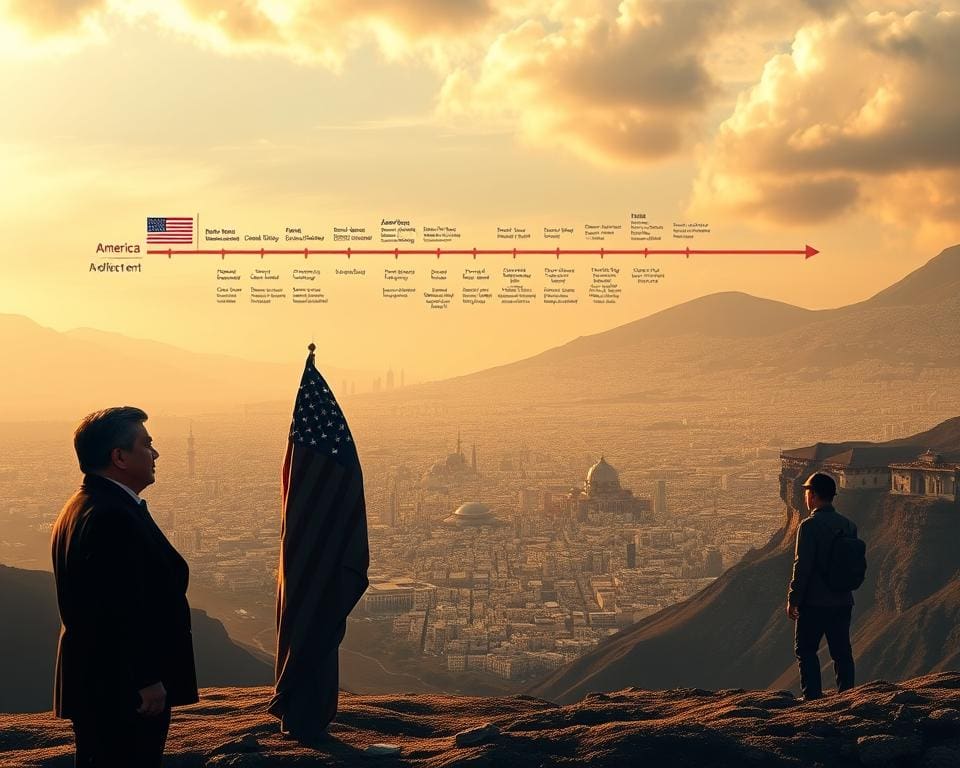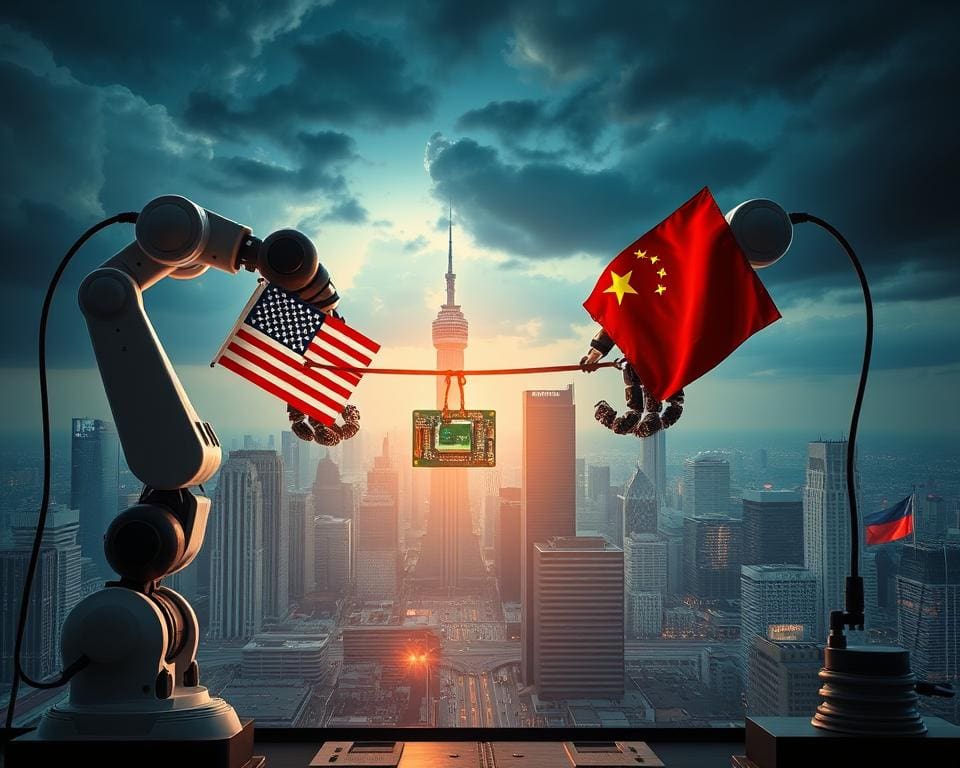The technological rivalry between the United States and China has transformed into a complex battleground that significantly impacts global dynamics. Known as the America-China relations, this ongoing conflict underscores the escalating tensions stemming from the US-China trade war. Both nations are vying for dominance in innovation, with initiatives like China’s ‘Made in China 2025’ driving competition. The realm of technology is not merely a sector; it is a national priority, with profound implications for geopolitics and economic stability. Key insights from institutions such as the Council on Foreign Relations and the Brookings Institution reveal the urgency of this tech war, as each country navigates a swiftly changing landscape where technological supremacy could dictate future outcomes.
Understanding the America-China Relations
The evolution of America-China relations plays a significant role in shaping the global landscape. This complex diplomatic interaction has historical roots dating back to the 1970s, a period that marked the formal establishment of ties between the two nations. Understanding the historical context helps to elucidate the current tensions that characterise their relationship today.
The Historical Context of America-China Relations
In the 1970s, the realignment of diplomatic relations marked a pivotal moment in the history of America-China relations. The opening up of China under Deng Xiaoping introduced new economic opportunities and initiated trade that benefited both countries. Yet, significant events shifted this dynamic, notably the Tiananmen Square incident in 1989, which had a profound impact on America’s perception of China’s governance and human rights issues.
Transitioning into the 21st century, the accession of China to the World Trade Organisation in 2001 was another turning point, leading to a surge in economic integration. This growth showcased China’s burgeoning technological capabilities and its role as a global economic power, further complicating America-China relations.
Key Events Leading to the Current Tensions
Several key events have exacerbated the current tensions between both nations. The South China Sea disputes emerged as a significant flashpoint, creating friction over territorial claims and freedom of navigation. Additionally, the 2008 financial crisis revealed vulnerabilities within both economies, prompting shifts in policies and increasing competition. With the rise of protectionism and conflicting interests, the landscape of America-China relations continues to evolve under the weight of these historical influences.

Technological Competition Between the US and China
The landscape of technological competition between the United States and China continues to evolve, marked by intense rivalry among the major players in tech. Companies such as Huawei, Apple, and Qualcomm serve as pivotal actors in this ongoing contest, influencing not just market dynamics but also the broader geopolitical climate. As these firms adapt to regulatory pressures and shifting alliances, their strategic choices will significantly impact national security interests for both nations.
Major Players in the Tech Industry
At the forefront of this technological competition are significant companies that shape the future of technology. Huawei, known for its advancements in telecommunications, faces scrutiny due to national security concerns. Apple, a leader in consumer electronics, navigates challenges related to supply chains and international trade policies. Qualcomm, a major player in wireless technology, plays a crucial role in the development of next-generation networks.
- Huawei: Pioneering telecommunications yet facing security bans.
- Apple: Balancing innovation with regulatory scrutiny.
- Qualcomm: Driving advancements while contending with trade tensions.
The Role of Innovation in National Security
Innovation stands as a cornerstone in the realm of national security, particularly regarding technology deemed essential for modern warfare and strategic dominance. Developments in artificial intelligence, 5G technology, and other emerging fields carry profound implications for military readiness and intelligence capabilities. Nations must harness innovation to ensure competitive advantage, with every breakthrough potentially altering the balance of power on a global scale.
Who America Tech War China: Implications for the Global Market
The ongoing America-China tech war significantly influences the global market landscape. Businesses are navigating a challenging environment shaped by shifts in supply chains and evolving international trade agreements. As tensions escalate, companies worldwide must adapt to these changes to maintain competitiveness and resilience.
The Impact on Global Supply Chains
Disruptions in the America-China relationship have made global supply chains increasingly fragile. The imposition of tariffs has compelled many firms to reconsider their sourcing strategies, leading to a potential reconfiguration of manufacturing locations. Companies striving for efficiency now face the dual challenge of rising costs and the need for agility in a landscape that can shift overnight.
- Manufacturers may relocate facilities to countries with lower tariffs.
- The search for alternative suppliers has intensified, driving companies to diversify their partnerships.
- Supply chains must now incorporate greater flexibility to mitigate risks associated with sudden geopolitical changes.
Effects on International Trade Agreements
The ramifications of the tech war extend to international trade agreements that have traditionally governed global commerce. Key negotiations, such as the Phase One trade deal and discussions surrounding the Trans-Pacific Partnership, play a crucial role in reshaping market dynamics. As countries navigate the complexities of these agreements, the impact on the global market will be profound.
- Existing agreements may be re-evaluated to reflect new economic realities.
- Countries may pursue bilateral agreements to safeguard their interests amidst uncertainty.
- Adjustments in trade relations could result in economic shifts that redefine competitive advantages across various sectors.
Political Tensions and Their Influence on Tech Policies
The interplay between political tensions and tech policies remains a defining factor in shaping the future landscape of innovation. Both the United States and China are navigating complex arenas where government regulations play a critical role in determining the trajectory of their tech industries. The implications of these political circumstances extend far beyond borders, influencing global markets and economic trajectories.
The Role of Government Regulations
Government regulations are increasingly reflecting the underlying political tensions between global powers. In the United States, legislation such as the Foreign Investment Risk Review Modernization Act (FIRRMA) has emerged, aiming to scrutinise foreign investments in sensitive technology sectors. These regulations stem from concerns over national security and the strategic positioning of the country within the global tech framework. Similarly, Chinese authorities are adapting their own regulations in response to international scrutiny, leading to an evolving regulatory landscape that tech companies must navigate.
How Political Agendas Shape Tech Landscapes
Political agendas heavily influence tech policies on both sides. In the US, the lobbying efforts of major tech corporations often seek to sway government decisions in favour of favourable regulations. This tug-of-war between corporate interests and national security concerns exemplifies the delicate balance policymakers must strike. In China, the government’s approach to tech governance reflects a prioritisation of state control and the promotion of domestic innovation, reshaping the tech landscape to align with broader political objectives. Navigating these challenging waters requires astute awareness of both domestic and international political narratives.
Cybersecurity Concerns in the Tech War
The ongoing technological rivalry between the United States and China has significantly escalated concerns regarding cybersecurity. As both nations strive for dominance, notable cyber attacks have become a focal point, revealing vulnerabilities that threaten national security. Understanding the implications of these attacks is essential for building robust defence mechanisms and fostering cyber resilience.
Notable Cyber Attacks and Their Consequences
Recent years have seen an array of notable cyber attacks that underscore the severity of the threats faced. One significant incident, the SolarWinds hack, compromised numerous government and private sector entities. This attack highlighted how state-sponsored actors can infiltrate critical systems, leading to data breaches that can have far-reaching effects. The repercussions of such incidents jeopardise sensitive information and erode public trust in technology infrastructures.
Strategies for Enhancing Cyber Resilience
To combat these rising threats, organisations must adopt comprehensive strategies to enhance cyber resilience. Key approaches include:
- Investing in advanced cybersecurity infrastructure to identify and mitigate potential breaches.
- Fostering public-private partnerships that facilitate information sharing and collaborative responses to cyber threats.
- Conducting regular training and awareness programs to ensure that staff remain vigilant against social engineering attacks.
Through these initiatives, organisations can fortify their frameworks and create a more resilient cybersecurity landscape, prepared to face the challenges posed by ongoing geopolitical tensions.
The Future of Military Conflict and Technological Supremacy
As the tech war between the United States and China escalates, the spectre of military conflict looms large, driven by an insatiable quest for technological supremacy. Gunpowder has evolved into data, with nations vying for control over advanced military technologies such as drones, artificial intelligence, and cyber capabilities. The ongoing advancement of these technologies not only shapes military strategies but also raises profound questions about ethics, security, and the very nature of warfare in the 21st century.
The implications are profound; military conflict could soon pivot from traditional battlegrounds to arenas where strategies are dictated by technological innovation. A cyber-attack could not only cripple infrastructure but also serve as a prelude to physical confrontation, making the landscape of international diplomacy increasingly precarious. In this context, nations must tread carefully as they navigate the fine line between competition and collaboration, acknowledging that the future of global stability hinges on diplomatic engagements that embrace innovative governance.
Yet, amidst this challenging backdrop, there is an opportunity for forging cooperative frameworks that prioritise peaceful resolutions and shared technological advancements. International dialogues focused on reducing the potential for military conflict may yield avenues for establishing norms surrounding military technology usage. In a world where the balance of power is intricately linked to technological supremacy, it is imperative for states to work collectively towards shaping a secure and ethical future that harnesses innovation for the collective good.









